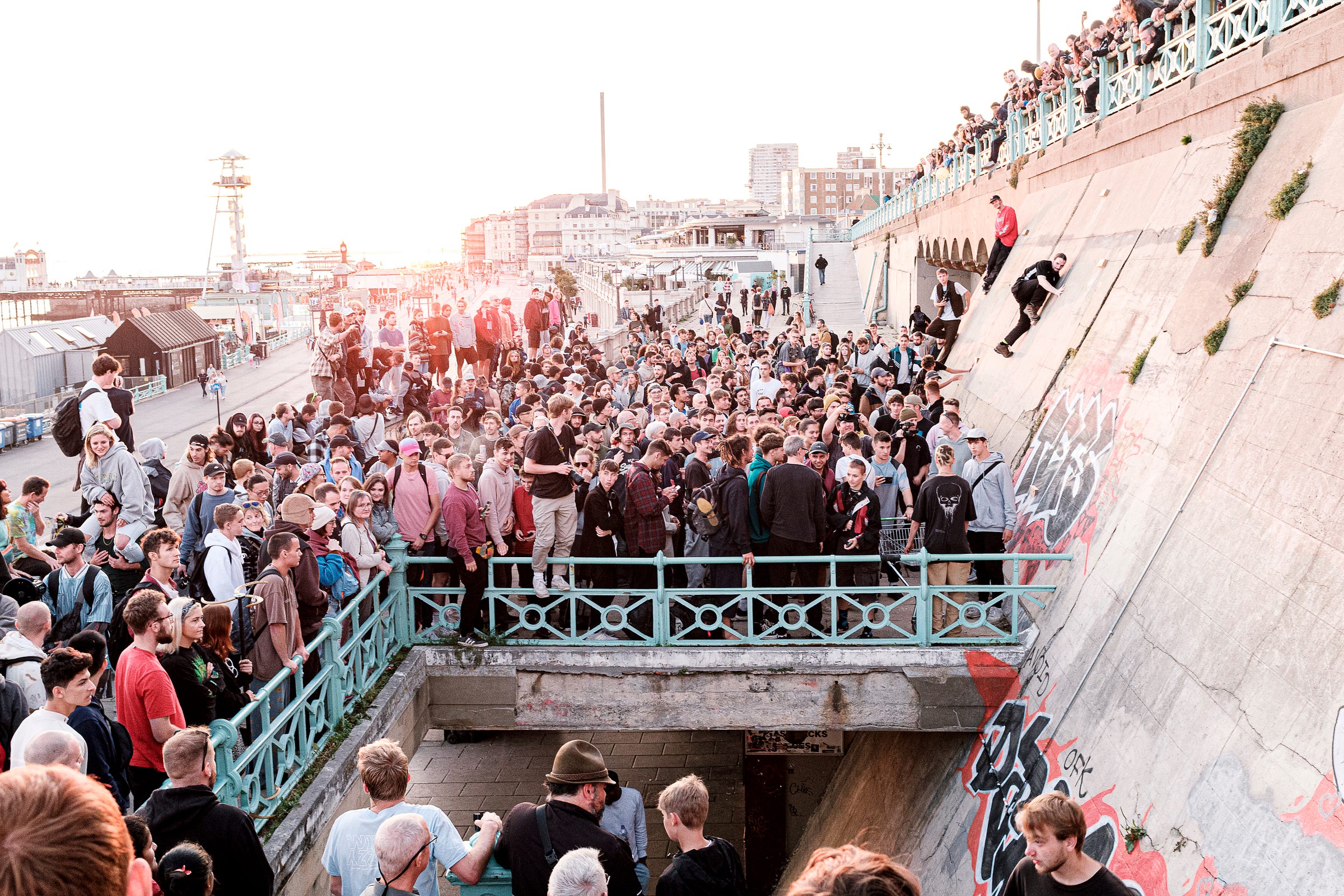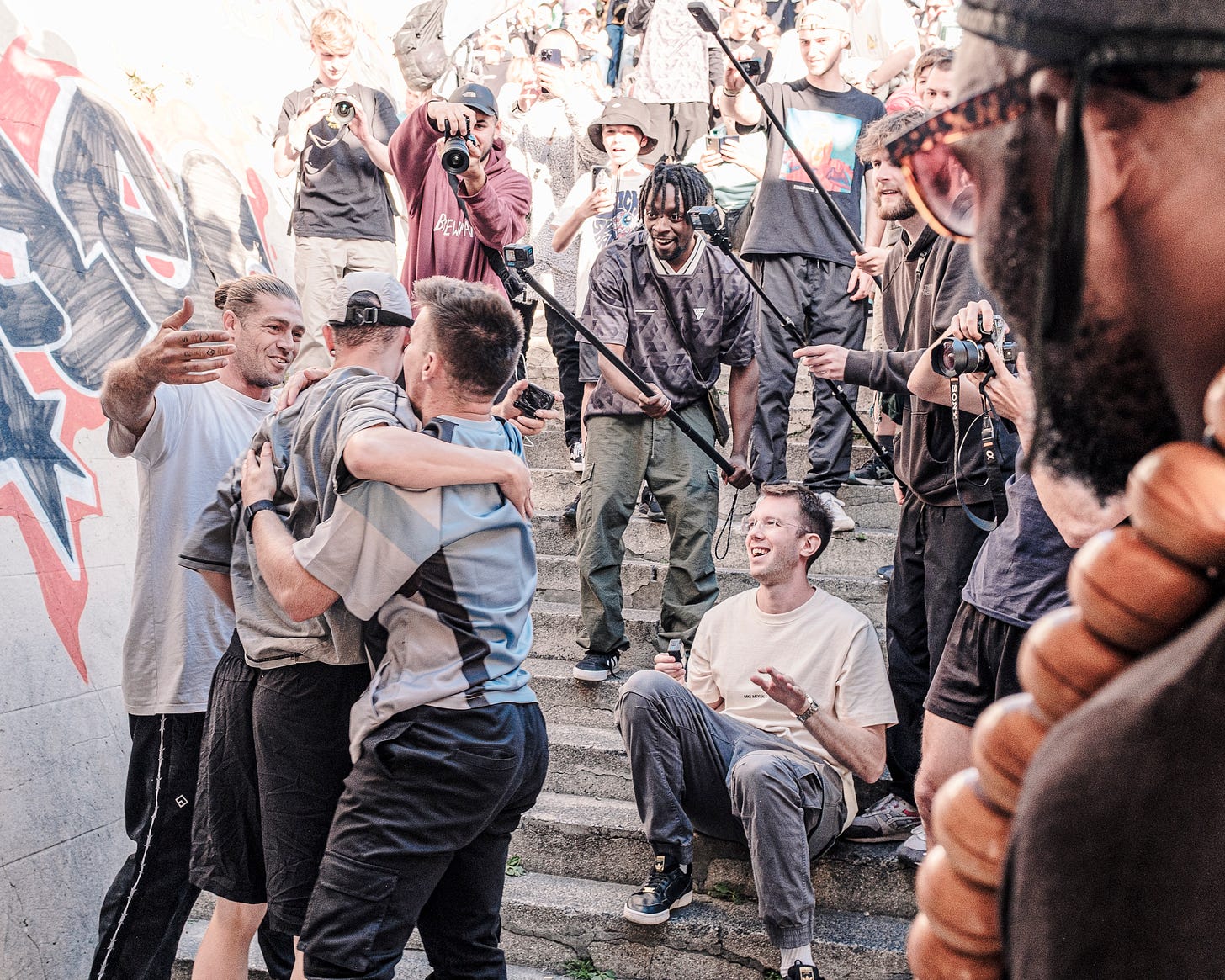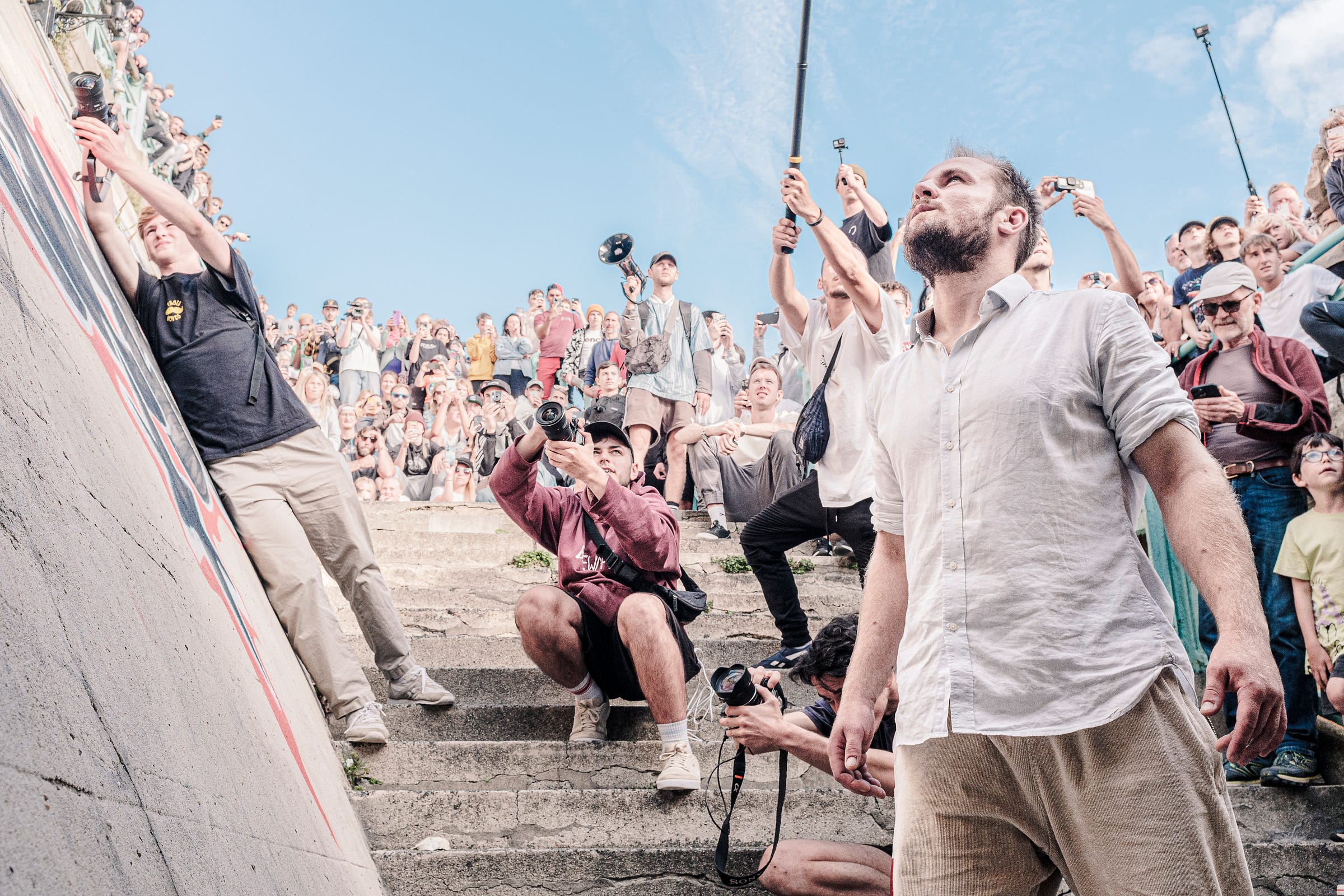A year ago, the parkour group Storror hosted a guerrilla public event in my home city of Brighton, inviting an international cadre of world-class athletes, their devoted online audience, and whoever was passing by to engage in a spectacle of running, diving, sticking, flipping, and simply playing, on the angled surface of a big wall near the beach.
The “Big Wall Open” was not only interesting for how it converted — perhaps for the first time — parkour’s massive online virality (Storror have over eight million YouTube subscribers) into a real-life spectator event, but also for its place in the sporting and political history of its location, and the present status of parkour within the much larger arena of international sporting bureaucracy.

In the city of Brighton, on the south coast of England, is a very big wall.
Constructed in the early 19th century to stabilise a 20 metre-tall cliff face, the wall has been the backdrop to a lot of movement. Peering over its sea-green railings in 1905, spectators watched Clifford Earp screech out a win in the first edition of the world’s longest-running motor race, the Brighton Speed Trials. On a Whitsun weekend in 1964, the wall was witness to the famous fists-and-deckchairs “Battle for Madeira Drive” fought between two ’60s youth subcultures, the Mods and Rockers, and immortalised in The Who’s 1973 rock opera, “Quadrophenia”. The road is home to the finishing lines for marathons and cycle races, for which spectators line the top of the wall and its colonnade of cast-iron arches in one long linear stadium.
On September 18th, 2022, though, as leading parkour athletes gathered from across the world to dash, dive, and scramble across it, the wall was no longer just the backdrop to events: it was the arena itself.
The “Big Wall Open” was hosted by Storror, a parkour team founded in the city in 2010. Over the past twelve years, the athletes and YouTubers have garnered over a billion views on videos ranging from parkour ‘rampages’ through the Negev Desert, to balancing acts and precision challenges over open water, and staged escape sequences from disused prisons. By now the best-known name in a still relatively niche sport, a Storror clothing brand, video game, and stunt-double feature in Micheal Bay’s 2019 Netflix feature 6 Underground, ensued.
As the team’s members have gotten older (its members are now in their late 20s), however, Storror’s focus has been shifting: away from the notoriety of death-defying stunts between Seoul skyscrapers, and towards a role as the voices, storytellers, and organisers of the parkour community. 2022 saw the launch of a podcast, highlighting the sport’s up-and-comers, and the on-boarding of members from another parkour group, The Motus Projects, to run clothing production and sales.
The first event of its kind and scale, though, the Open was another challenge. Hosting a sporting spectacle without permits or permissions; and converting their online audience into a real-world crowd.
Peaking somewhere in the few hundreds around 5p.m., the crowd had gathered from as far away as Edinburgh; but many were there by chance — a walk to the beach interrupted by almost unbelievable traversals of a typically mundane space. The Open’s world-class athletes, travelling from as far as Australia to attend, had remade what a big wall could be, throwing down increasingly daring, if not foolhardy, ways of navigating the eighty-degree surface over a 13-foot drop to the concrete stairway below. (The event ended with 17 year-old hometown athlete Yanik Sawicki riding a half-broken shopping trolley into the sunset, having landed in its basket off the back of the 7-metre long wallrun). At the crowd’s edges, children could be found jumping up against the wall, mirroring the high-risk moves on display around the corner.

Despite its guerrilla organisation, police presence at the event was minimal, officers engaged with a trans rights protest elsewhere in town. When, around halfway through the event, two community support officers made an appearance asking for the crowd to be moved on, Storror’s Sacha Powell, recording the event on a camcorder, told me they were too late: “what are they going to do? There’s hundreds of us, and two of them.” The carnival had begun, and would not easily be stopped.
The success of such an unregulated, community-lead event comes at a critical time for parkour, whose (ultimately overturned) inclusion in the 2024 Paris Olympic Games has been the subject of fierce debate in recent years. The discipline’s proponents, participants, and audience recognise the huge boost in recognition and funding that Olympic status could bring to a sport seeking to expand its reach, but express concerns over its core spirt of play and freedom being lost if not administered from within. In 2017, the International Gymnastics Federation’s bid to administer a potential Olympic events schedule united six national parkour bodies in the formation of Parkour Earth, the sport’s nascent international governing body. Parkour Earth’s then chief executive, Eugene Minogue, soon described the F.I.G.’s bid as a ‘hostile takeover’, and the group is still campaigning for the right to run an Olympic events schedule under its own rules, though the I.O.C. is yet to grant them official recognition.
Whatever happens in the bureaucracy of international sporting administration, Storror and groups like it are carving their own future for parkour’s public face, online and off. Hosting guerrilla competitions with small prize pools attended by their own enthusiastic audience, parkour’s community, challenge, and spirit of play remain the focus, inviting more to join the scene. Without any barrier between crowd and athletes, introductions at the Open would start ‘do you train?’ Seen right before their eyes, the answer to many was ‘No, but maybe I could start.’

Beginning in the banlieues south of Paris in the late 20th Century, parkour, like skateboarding, has its places of pilgrimage: iconic ‘spots’, and their historic stories formed both by the sport’s founding heroes and classic urban legend. The Open was proof again of parkour’s powerful connection between play and place. At the Brighton Big Wall, parkour athletes have been one-upping each other’s feats for nearly two decades (a few generations in a sport of such recent history), preceded by drunken 20th century fishermen who once ran along the wall only to inevitably tumble from it. The nickname “Suicide Wall Run” emerged from these travails.
But the Big Wall Open also responds to, and reanimates, the wall’s wider history of spectacle and action. Since 2012, the arcade of arches at the wall’s base — the longest cast iron structure in the world — has been closed off due to corrosion from the the sea air. Since then, a combination of crowdfunding, borrowing, and council budget allocation has secured £11.5m to restore at least 40 of the 151 arches — less than half the estimated cost of a full restoration. Work is due to start soon, with new business developments and a 50m outdoor swimming pool already complete on the beachfront nearby.
The closure left Madeira Drive, and the beach below it, harder to access from the city’s East unless by car. During the pandemic, though, traffic was banned from the road in favour of bikes and pedestrians, and the tarmac became a civic promenade once again: for leisure, and for protest. In June of 2020 the largest march in the city's recent history saw 10,000 people gather down the road’s entire length in support of Black Lives Matter. Then, in July, the Mods and Rockers of that infamous 1964 battle banded together to campaign for the road's reopening to motor vehicles.
Into this semi-dormant, but contested, space, then, the Big Wall Open offered a new vision of activity and festival at the beach: centred around play, challenge, and community.

Playing comperes, Storror’s Benj Cave and Drew Taylor cajoled the crowd through megaphones, clearing run-ups and landings, and announcing challenges for £100 prize pools. Even so, the event seemed to run on a momentum all its own, as athletes prepped, and then attempted, ever more audacious moves. Ed Scott, the eventual winner of the men’s category, ran a head-to-head with Phil Doyle for a never-been-done “stick” to a handrail (landing precisely like a gymnast and halting all movement) out of a big three-step leap across the wall over a perilous drop. Having lost that competition after several attempts, Doyle, still wearing a crisp collared shirt, soon went for a pint. In his absence, Dom Tomato, the Red Bull athlete known for viral larger-than-life stunts across impossible seeming gaps and drops, dived into what can only be described as a vertical roly-poly against the wall before sliding straight down it, soliciting a “What was that!?” From Storror’s Max Cave.
On the stairwell’s other side, athletes were taking on smaller, more gymnastic challenges across a series of timber handholds illicitly drilled into the wall the night before. Toby Segar, Storror’s most physically powerful athlete and the holder of a world record for the world’s longest “cat pass” vault, took his own prize money for pulling off a 360° spinning ‘dyno’ leap between two distant holds, doubling the award for the next challenge. Later, a trick jam saw athletes contort their bodies against the angle of the wall in the most creative, mind-bending way s they could conjure: whatever rules this playground had quickly dissolved and reformed, time and again.
There is no missing the Big Wall Open’s intensely-recorded nature. Before Sawicki’s sunset trolley antics, Tomato could be heard joking ‘Can we get a few more phones up in the air please? A few more phones filming please — there’s not enough’. Travis “Verky” Verkaik, the 22 year-old winner of Red Bull Art of Motion 2022 (parkour’s most prestigious official competition), sat out participation in the Open due to injury, but live-streamed his view of the entire event to thousands. Highlights and clips have been viewed several million times, with a series of angles available for each key moment.
The rise of parkour and social media have gone hand in hand. Storror, influenced by parkour’s representations in traditional media, like Sébastien Foucan’s role as a parkour-wielding terrorist in the 2006 James Bond film Casino Royale, have used YouTube to portray a more authentic version of the discipline: its mental battles, as well as its physical feats. Today, new athletes influenced by Storror are riding the rise of TikTok and other short-form video platforms towards huge virality. The sport instantly meets what Colin and Samir, YouTubers who cover the ‘creator economy’, describe as the ‘over the shoulder test’: seeing a parkour clip for even a couple seconds, you instantly understand the stakes, the commitment, and the payoff, even without the sound.
But, like with many action sports, parkour feats often appear smaller and less impressive in video than they are in real life. It can be hard to truly gauge how heavy the falls hit, how daunting the drops feel, and how powerful and fast the leaps must be when it’s not happening right in front of you, athletes clearing gaps between railings, stairs, and walls with eye-popping precision. At the Big Wall Open, a crowd of hundreds gathered to see how terrifying, impressive, and exhilarating it really is: there and in person, as thumping landings pushed vibrations across the concrete deck and into our feet. Along the way, as athletes bailed, leapt, rolled, and stuck, almost impossibly, to the wall, a global community of parkour’s practitioners and spectators mixed as one without boundary, and a semi-abandoned platform on England’s south coast came alive with movement.

My own appearance in footage from the Open comes in Storror’s highlights video, as Ed Scott repeatedly attempts a side-flip against the wall and onto a handrail, coming so very close to the kind of brutal head injury high divers suffer against their own diving boards. “I don’t know if I want to keep watching this one,” I say, as Scott tries to mentally figure out the geometry of the move: “if it goes wrong, it’s going to go really fucking wrong”.
“Don’t jinx it,” says the kid next to me, maybe only 14. Storror’s Powell chips in from behind the camera, “It’s going to go perfectly.” And then it does.
Taking a snappy run-up, Scott pushes off the concrete, spins his head beneath his legs, and lands neatly on the rail. The crowd, and I, erupt.














